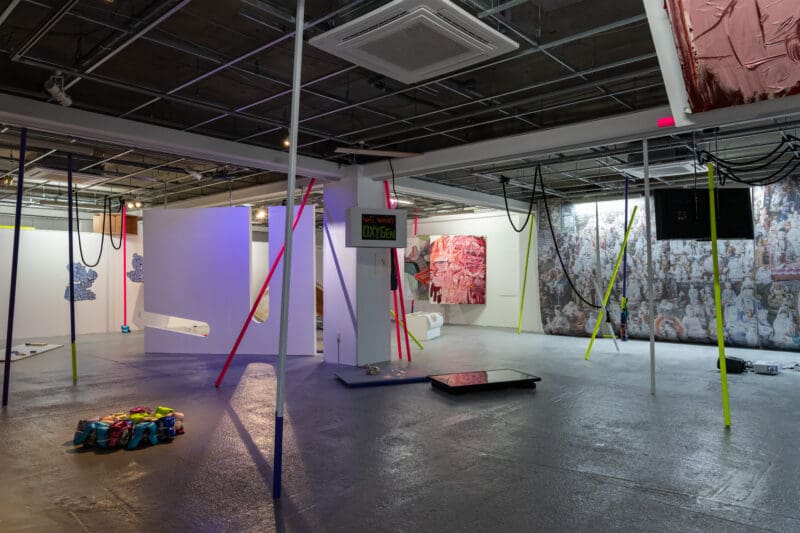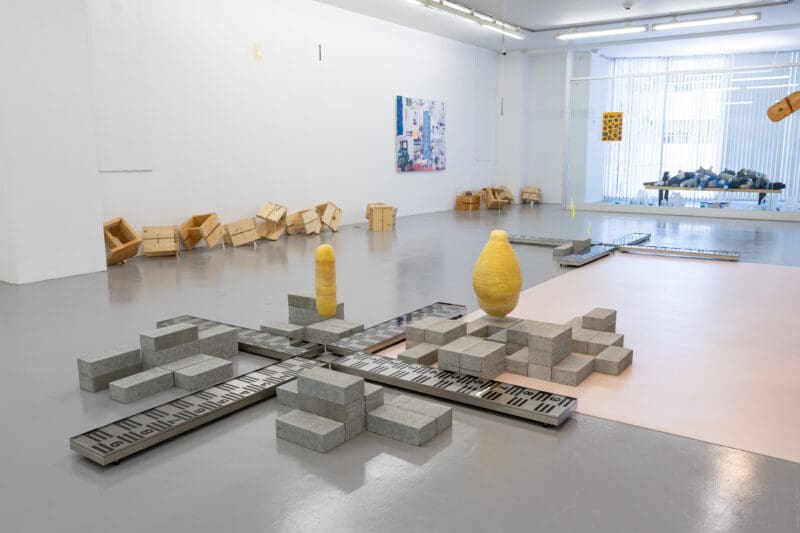FROM dynamic multi-layered mixed-media installations to AI-generated digital realms, Yutaka Inagawa is no stranger to subverting traditional art-world norms.
Now, having further developed his curational work, Inagawa has just opened a new exciting exhibition at the Art Gallery Miyauchi, located in the heart of Hatsukaichishi. Titled Nurturing Nodes in the Nook of an Odd Sock, the latest showcase gathers the work of 19 distinct, trailblazing artists from across the globe.
Fusing paintings, murals, sculptures and more with tangling structural environments, the gallery space has been playfully transformed into a breathing biome of experimentation and individuality. Artworks weave and entwine in an eclectic display of fearlessness and fervour – traits intrinsic to Yutaka’s own artistic approach.
Showcasing work from Yu Araki, Bouie Choi, Anthony Chin, Kara Chin, Gary Clough, Taro Izumi, Rikako Kawauchi and many more, Inagawa’s careful creative storytelling imbues fresh meaning and contexts into each featured piece.
Reflecting upon the exhibition, Glass speaks to Inagawa about his thought process, the importance of artist intent, fluidity and ambiguity and the introduction of emerging technologies against the artistic cultural milieu.

Your new exhibition is undeniably playful and experimental. What is the inspiration behind the exhibition name ‘Nurturing Nodes in the Nook of an Odd Sock’?
The inspiration for “Nurturing Nodes in the Nook of an Odd Sock” stems from the 2023 “Big Motor Incident” in Japan, where golf balls were stuffed into socks to damage car bodies for insurance fraud. While this act highlights social distortions, I was intrigued by interpreting it through a creative lens. Viewing the act of deforming a car’s metal surface with “a golf ball in an odd sock,” one can see it as an unconventional form of creativity, detached from its original, nefarious context.
Additionally, the relationship between an artist’s intention or narratives and their artwork can be likened to a pair of socks. Artwork embodies the artist’s intentions, narratives, positioning, and identities within a complex cultural landscape. Even if a part of the “artist intention” is missing, its existence is always implied because the official “paired socks” have been published out there.

How did you select the 19 artists for this particular exhibition?
Primarily, I based my selection on the quality of their artwork and their personal qualities. Personal encounters, whether through other exhibitions, collaborative projects, or introductions by trusted friends, also played a significant role.
The invitation I sent to these artists was bold and could be seen as offensive or nonsensical. However, it was also an invitation to embrace the uncertainty and risk involved in this experimental exhibition. They knew there was a chance their artwork could be jeopardized by my interventions.
I also paid careful attention to the diversity of the artists, considering their varied backgrounds and the types of art practices, some of which were challenging to imagine fitting within the curatorial architecture I proposed.

Can you talk us through your process in creating the artworks’ bespoke environments? Did the architectural space make certain curatorial decisions easier?
I began by using digital photographs of the gallery spaces, provided by Art Gallery Miyauchi, to conceptualize various bespoke environments. The limitations of these photographs helped me generate multiple variations by responding directly to the imagery. Using Photoshop, I placed images of the artworks and made sketches with digital drawing and photo montage techniques.
To finalize the environment, I needed to be in the actual space, experiencing its architectural characteristics with all the artworks and physical elements present.
Was it difficult to have some artists approve the bespoke environments?
When I explained the curatorial framework and related conditions, I informed the artists that I wouldn’t share any progress or plans in advance. This is partly because my creative process is nonlinear and spontaneous. I continuously change plans, and the setup phase is also a creative session for me.

What is the greatest challenge of curating projects in a non-conventional space?
The greatest challenge lies in shifting our perception. The idea of a fixed template, format, or formula for creating exhibitions is often deeply internalized. In the web of interconnectedness, nothing will be perceived as standalone entities. If you move one element, other elements might also need adjustments or even new statuses, meanings, positions, or forms.
You previously curated Duddell’s Another Pair of Eyes in 2019. How do you think your curatorial style has evolved over the years?
My curatorial style and art practice are deeply interrelated. I had three solo shows in 2022-2023—one in Singapore, one in Hong Kong, and another in Japan. Additionally, the online collaboration “Say to Day (2020)” with inspirational curator Ying Kwok was a pivotal point that impacted these solo exhibitions.
For this latest curatorial experiment, the experience I had with the admirable Hong Kong-based Singaporean collector Cindy Chua-Tay for Duddell’s Another Pair of Eyes in 2019 played a significant role. When she kindly invited me to her beautiful home in Hong Kong to see her collection, I was profoundly inspired by how meticulously she curated her space.

How do you find new artists, new ideas as a curator?
As I value a personal connection with the artists themselves, as well as their artwork and practices, how I meet them or who helps me get connected with them is quite important. Sometimes, even a brief exchange of ideas is enough to leave a significant impression.
In terms of ideas for experimental shows, I often draw inspiration from small details in news about social malfunctions, cultural deformations, political issues, individual mourning, and daily remarks on platforms like X and other social media as well as other daily encounters.
What would you say are the key themes of this exhibition?
It’s more of a demonstration or exploration of how to develop creative dialogues with polyphonic entities without simplifying their complexity or making the illogical logical. Multiple themes can be interpreted and generated by the audience/visitors.

Your own work often delves into the contrast between the real and digital realms. Now, this exhibition features Chat GPT-created avatars. What is your stance as a whole on AI art? Do you believe it to be a threat or a creative tool?
So far, the way I use AI-generated text or images is largely an extension of manipulating digital entities or materializing the idea of “the other side.” I don’t rely on or am particularly interested in AI’s ability to create a polished end result instantaneously. If AI-generated materials float without being anchored to the human side of the artist, they are probably just eye candy, nothing more. However, I must remain open and continuously update my perspective as the impact of AI increases at an unprecedented speed.
Nurturing Nodes in the Nook of an Odd Sock is on until the 30th of June 2024.
For more information, please visit here.
by Sophie Richardson
The artist-curator, Yutaka Inagawa, took some of the photographs, while the rest are the work of Kensuke Hashimoto. All images are displayed courtesy of Art Gallery Miyauchi.
